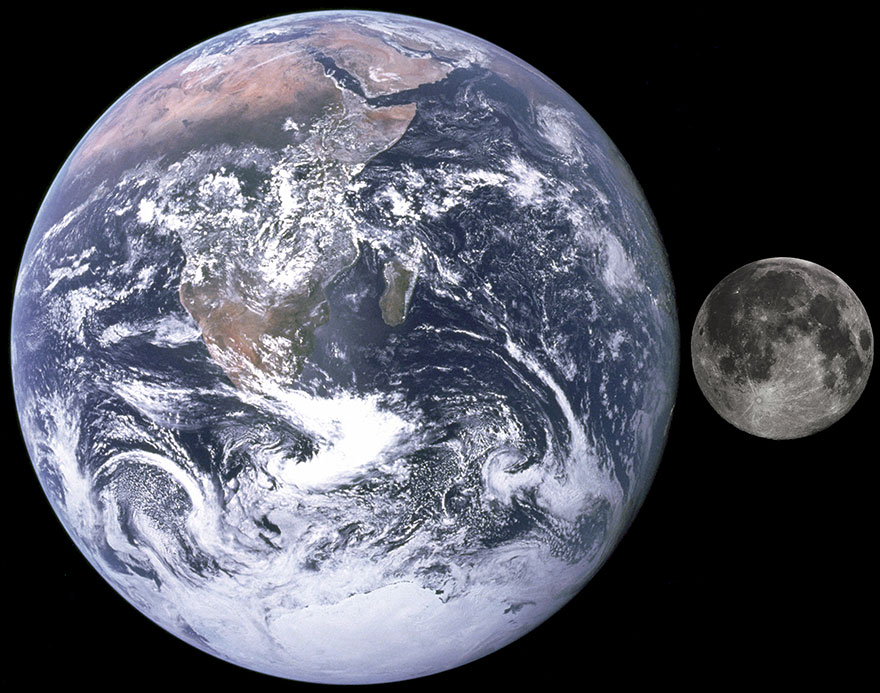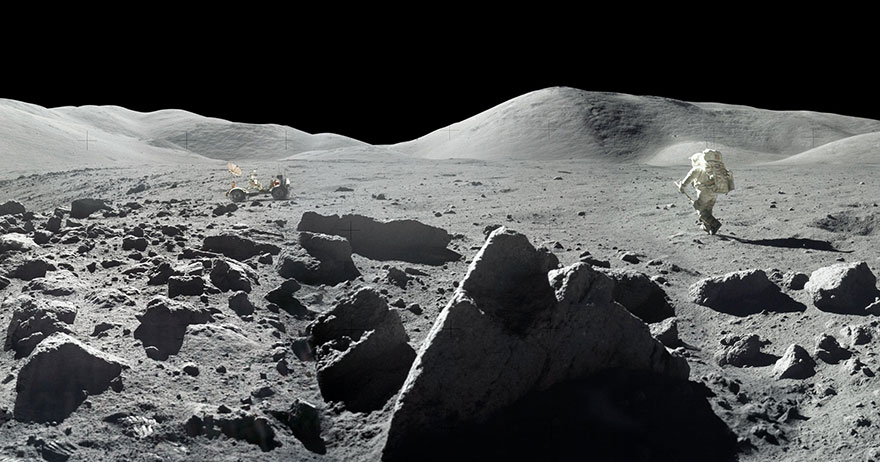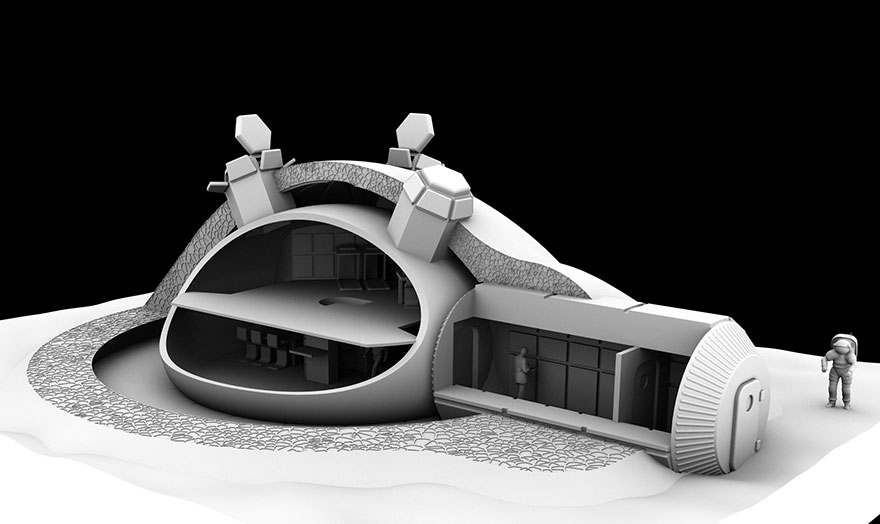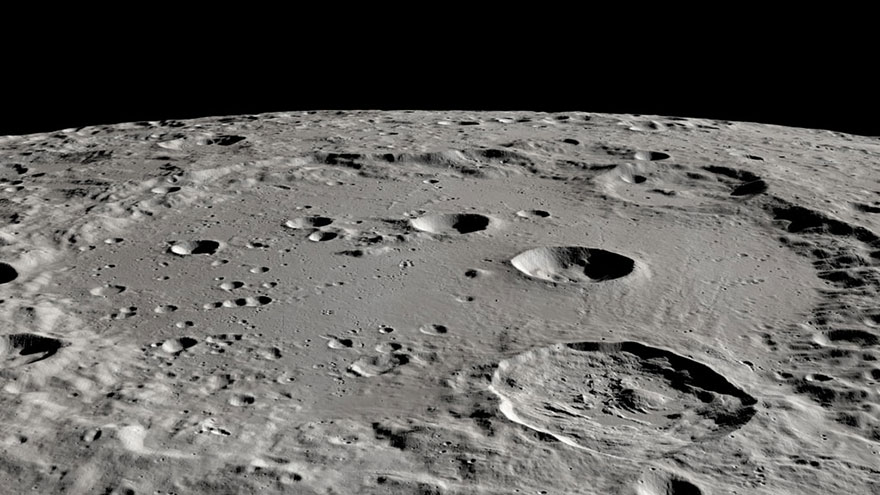The Moon, a whole new world (for youth)
On this page
The Moon is the only celestial body (besides Earth, of course!) that humans have ever set foot on. We discovered a fascinating world, but one that is very different from our planet. When you look up at the Moon, do you ever wonder what it would be like to go there? What kind of world would you find?
Here are the answers to some questions to help you discover the fascinating world of the Moon.
How does the Moon compare with Earth?
At first glance, the Moon and Earth look very different. First, the Moon is about four times smaller. On Earth, we see oceans, continents and clouds, whereas on the Moon, the surface is more uniform: it is all grey, with craters and some darker patches.

The Moon is much smaller than Earth. (Credit: Creative Commons)
These patches, called maria, are actually plains of dark rock created by ancient lava flows. The name maria, meaning seas in Latin, comes from the fact that astronomers once mistakenly believed that those dark areas were really seas, just like on Earth!
Conditions on the surface of the Moon are also very different from conditions on Earth. Since the Moon has no atmosphere, the temperature varies greatly between day and night. When the Sun warms its surface, it is about 120 °C, while at night it can drop to -233 °C. Since there is no atmosphere, the sky is always black, even in the daytime. On Earth, the atmosphere makes the sky bright and clear because it scatters the light in all directions. Without an atmosphere, the sky remains black. Also, on the Moon, we feel much lighter because gravity on the surface is six times weaker than on Earth's surface.

Photo montage of the lunar landscape captured by the astronauts of the Apollo 17 mission. (Credit: NASA)
Where the Moon is more like Earth is in its composition. The minerals found on the surface of the Moon are similar to those found on Earth. That information, revealed by analysis of the moon rocks brought back by the Apollo missions, which took place between and , has helped us better understand how the Moon formed.
Each day and night on the Moon lasts almost 14 Earth days! The time between each sunrise is equal to the time between two full moons or two new moons, which is 29.5 Earth days.
Could we live on the Moon?
No, it would be impossible to live on the Moon without sophisticated equipment or a moon base. Conditions on the surface are not at all conducive to life in general and are particularly dangerous for humans!
- It is either much too cold or much too hot: -233 °C at night and 120 °C during the day.
- There is no atmosphere, which means no oxygen to breathe.
- There is no liquid water, which we and the plants we eat need to survive.
- With no atmosphere or magnetic field to protect it, the Moon's surface is constantly bombarded by harmful rays from space.

Artist's view of a future moon base. (Credit: ESA/Foster + Partners)
Plans are being made to build a moon base one day! It's a huge technical project: engineers have to make sure that all the risks and dangers on the Moon are eliminated as much as possible and find ways to supply the base with food and water.
Why are there many craters on the Moon and not on Earth?
Craters are holes in the ground. They form on the solid surface of a moon, planet or other celestial body as a result of impacts by rocks from space (meteorites). As those impacts take place at very high speed, the crater is always much larger than the rock itself.
There are thousands of craters on the surface of the Moon. Some are hundreds of kilometres wide, while others are tiny. There are even craters inside craters!

The grey surface of the Moon has many craters of all sizes. (Credit: NASA)
The number of craters on the lunar surface is surprising, especially when compared with Earth. In fact, Earth is also hit by rocks from space, but the vast majority of them are destroyed in the atmosphere and do not reach the ground.
There are many well-known craters on Earth. Can you name a few? Here are some examples:
- Manicouagan Reservoir, in Quebec: This crater is very easy to spot from space. Several astronauts, including David Saint-Jacques, have taken photos of it from the International Space Station.
- Sudbury Basin, in Ontario: In , the Apollo 17 astronauts visited the basin to study the shatter cones for their mission to the Moon.
- Charlevoix Crater, in Quebec: The third-largest crater in Canada after Manicouagan and Sudbury.
- Haughton Crater, on Devon Island, Nunavut: One of the places our Canadian astronauts go to receive geology training.
- Chicxulub Crater, in Mexico: The impact that created this crater (now buried under the Yucatan Peninsula) is believed to have caused the extinction of the dinosaurs.
In addition, over time, Earth's surface is altered by volcanoes, erosion and plate tectonics. Because of these phenomena, most of the craters that formed on Earth in the past are no longer visible. On the Moon, there are no such processes to change the surface. Some of the craters we see are billions of years old!
How many people have been to the Moon?
In all of human history, only 12 people have set foot on the Moon. They are all astronauts from NASA's Apollo missions, which took place between and .

The control center of the Apollo 11 mission, which put the first humans on the Moon. (Credit: NASA)
Those 12 astronauts are well known, but it is important to remember that thousands of women and men, many of them behind the scenes, worked to make the missions a success. There were many technical challenges in putting people on the Moon: leaving Earth's orbit, getting to the Moon, getting into lunar orbit, landing safely on the Moon, and taking off again from the Moon to make the trip back to Earth. And all that with the technology that was available over 50 years ago! Fun fact: Our mobile devices are much more powerful than the computers used to send astronauts to the Moon.
The first woman to set foot on the Moon . . . hasn't done it yet! The 12 astronauts who walked on the Moon were all men, and all from the United States. That will soon change! Canada is one of the partner countries involved in the Artemis missions, which aim to first send astronauts around the Moon and then land the first woman and the next man on the Moon in .
Why did the astronauts bounce on the Moon?
Gravity is what keeps us on Earth's surface. It is also because of gravity that any object thrown into the air falls back down. The force of gravity depends on the size and mass of a planet, moon or other object.
Because the Moon is smaller and has much less mass than Earth, the gravity on its surface is about six times weaker. So the astronauts felt six times lighter! It was easy for them to jump higher than on Earth, even in their heavy spacesuits. When you watch the videos of the Apollo missions, it looks like they're bouncing when they walk.
The absence of an atmosphere around the Moon has no effect on the perceived gravity. Astronauts in a pressurized moon base would also feel six times lighter even if they were surrounded by breathable air.
How did the Moon form?
According to the most likely scientific theory, when Earth formed about 4.5 billion years ago, it did not have a moon. Shortly after, a small protoplanet named Theia collided with Earth. The debris from that impact then clumped together and formed a small body orbiting Earth. The Moon was born! Since the debris that formed the Moon came from Earth and Theia, the Moon's composition is similar to Earth's, but not exactly the same. Earth's core had probably already formed at the time of the collision. As a result, the Moon has a composition similar to Earth's mantle (the layer above Earth's core).

The Moon formed during an impact between Earth and Theia, a protoplanet the size of Mars. (Credit: ESO/G. Glasø/M. Kornmesser)
Did you know?
The solar system formed about 4.5 billion years ago, when a giant cloud of gas and dust collapsed on itself. Most of the gas formed the Sun at the centre, and the debris around it formed the planets and all the other objects in the solar system.
